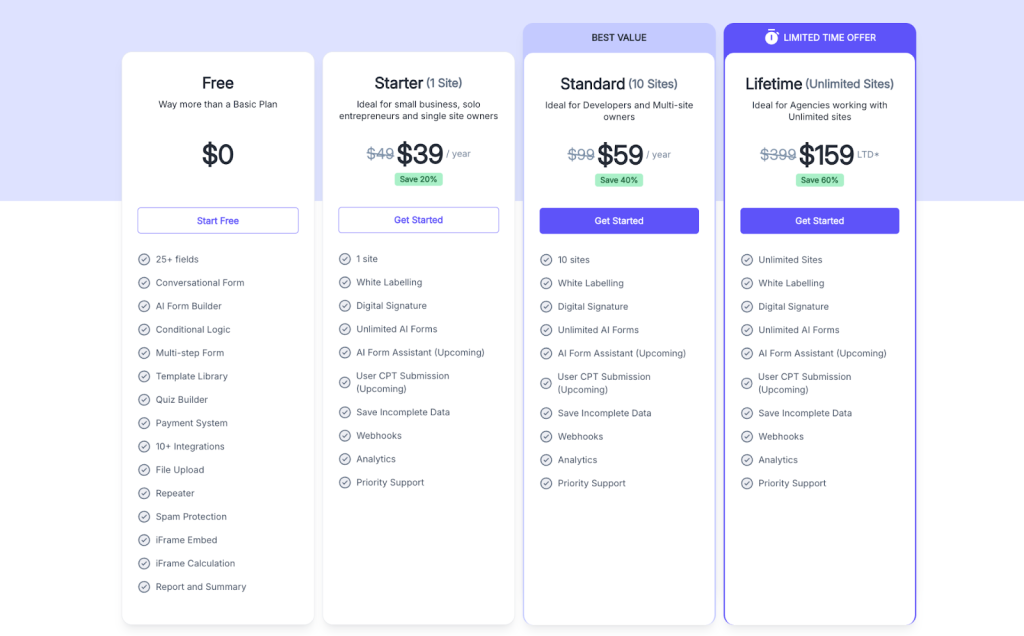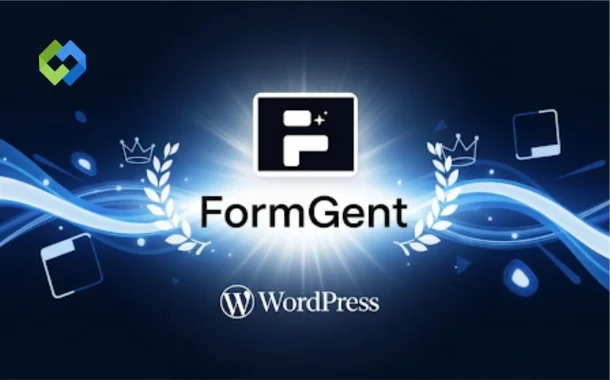Every few months, a new form plugin launches, often promising the exact same set of features with a slightly different interface. At some point, it almost feels tiring to see the same tool, same uses with a slightly different visual and similar pricing plans. Though new plugins are bound to be built to replace the old ones, sometimes it feels like they’re being built just to exist, not to truly solve user problems.
Our aforementioned tool is no different when we speak about functionality, use cases and other staff. However, it caught my attention for a very different reason. When I first discovered the FormGent plugin, it was in beta stage only developing functionalities at a rapid pace and still improving lots of basics.
Table of Contents
My First Impression of FormGent: More Than Just a Plugin, It Felt Like a Companion

I was not busy enough not to try a beta tool that seems interesting. Although there weren’t many interesting capabilities of it in the beginning. But I liked its goal – solving the affordability crisis small and medium businesses often face when maintaining thousand subscriptions to keep their website functional.
Frankly, form builders are a very basic yet essential plugin any WordPress website requires. There are hundreds of other tools and components that businesses find more important starting with their hostings, page builders, themes, securities, user management, content and subscription management.
Somehow FormGent addressed that matter well and challenged the market in a very different way – it’s 2025 and building forms with advanced functionalities should be accessible to everyone. Especially if you are already bleeding from so many subscription fees every month and year, we want to assure you that ours will not be in that list.
Instead of blending into the noise of pushing for upgrading your plan, it assures that their free plan is good enough. That doesn’t mean they dedicated the plugin to be free forever, they obviously have a pro plan in place. But upon reviewing that, I felt a breath of fresh air.
FormGent didn’t try to overwhelm me with bloated features or push into a paid upgrade right away. Instead, it focuses on the basics that matter, delivering a simple, clean, and reliable form-building experience that respects my time. After testing it out, I can say FormGent is more than “just another form plugin”; it’s one of the few free tools that actually feels complete from the start.
How I Came Across FormGent – The Accidental Treasure Hunt
Being a WordPress geek, I like to engage myself in community forums, reading blogs like WP Mayor, and staying close to the WordPress forum mostly. I’m the kind of person who enjoys jumping into discussions, answering questions, and learning from other users. That’s why, from the fear of missing out on anything new or trendy, I even set up Google search alerts to get notifications whenever something fresh pops up in the WordPress space.
To stay ahead of the curve, I even set up Google Alerts for anything that echoes in the WordPress ecosystem. Whenever something new drops in the city of WordPress, I want to be the first one to peek inside the box. And that’s exactly how I stumbled upon FormGent.
I was already paying $127 yearly for another form builder, mainly because I needed features like conversational forms and quiz builders. Those features were important to me, and I had accepted that paying for them was just part of the deal.
FormGent makes the quiz builder completely free. That was the turning point. It immediately made me curious. Why should I keep paying for something that another plugin was giving me for free?
Of course, the journey wasn’t as simple as it sounds. As WordPress users, we care deeply about where our money goes and the actual value we’re getting in return. That’s why I dug deeper. And what I found made me realize FormGent wasn’t just another form builder because the plugin is built in WordPress’s Native Block Editor.
You can add, edit, and customize forms as blocks. It feels like a natural part of WordPress, not an external add-on, witha faster and more consistent workflow. On top of that, it keeps your site lightweight. Easier for beginners, since it uses the same editor they already know.
Features That Felt Like Superpowers

When I dug deeper into FormGent, I realized it wasn’t just the free quiz builder that caught my eye. It was the way each feature solved real problems I face as a WordPress user. Here’s what stood out to me the most:
- Conversational Form Creation: I’ve always believed forms should feel like conversations, not interrogation sheets. With FormGent, I built a customer feedback form where users answered one question at a time. The experience was smoother, friendlier, and I actually saw a higher completion rate compared to my old static forms.
- Multi-Step Forms: Long forms are the quickest way to scare people away. I tested FormGent’s multi-step form while creating a mock job application form. Breaking it into small steps (with auto-save) made it so much easier for users to stick around and finish. It reminded me how important user patience is — and how FormGent actually respects it.
- Conditional Logic: This is where forms start feeling smart. I built a test form where if a user selected “business,” it showed fields relevant to businesses only. No clutter, no irrelevant questions. I loved how it felt personalized for every user — and that makes a huge difference in reducing drop-offs.
- Quiz Builder: This one was the real “wow” moment. I created a quick quiz for my blog readers and set up scoring right inside FormGent. To use this feature, I need to pay $127/year with my previous form builder. Here? Free. It worked smoothly and gave me everything I needed to make the quiz interactive and fun.
- Payment Integration: I tried building a test donation form with PayPal integration. Within minutes, I had a working payment form ready. The fact that I could even add custom payment amounts made it feel flexible enough to be used for events, checkouts, or client payments.
- AI Form Creation: I was curious, so I typed a prompt: “Create a client onboarding form.” In seconds, FormGent generated a full form for me. And then I just made some tweaks for a few fields. It saved me time and gave me a solid head start, something I never thought I’d need until I used it.
- Advanced Integrations: For me, a form builder is only as good as what it connects to. I tested the Google Sheets integration to automatically log responses. It worked like a charm. Knowing I also get tools like Zapier, MailChimp, and Slack for free just made it even sweeter.
- iFrame Embed: This was new to me. I tested embedding a form outside my WordPress site using an iFrame, and it worked flawlessly. This opens up so many possibilities like launching forms on landing pages or platforms where WordPress isn’t even in play.
- Instant URL: Sometimes I don’t want to publish a form on a page. With FormGent, I could just copy an instant URL and share it directly with someone. It sounds simple, but when you’re moving fast, this little thing saves so much time.
What Makes FormGent Feel So Different From the Crowd
Even as a free plugin, it is loaded with a complete toolkit that makes building forms effortless. Here’s what you can get instantly.
Collect Any Information You Need
Whether you’re running a job application, event registration, or client onboarding, FormGent’s 28 fields cover every possible aspect in my form building experience. In most cases I use text, email, phone, file uploads and many other blocks to create a complete form which I need. Normally, you need to upgrade your plans to get file uploads, but here you’re getting unreal benefits for free.
Keep People Engaged Till the End
A long survey or feedback form is boring and results in a significant drop-off in form submissions. With conversational forms, FormGent displays one question at a time, creating a friendly chat-like experience. For example, collecting feedback from parents for a summer camp or student registrations becomes smoother and more complete.
Save Hours of Work
With the AI Form Builder, you can type a prompt like “create a client onboarding form” and FormGent generates it instantly. If you want to add a radio or checkbox button, it will do that automatically, and you don’t need to fork again. Creating a form from scratch is time-consuming, so AI saves hours here.
Make Forms Feel Personal
Another exciting part is you can set logic behind your forms to get the exact results. You don’t need to create multiple forms because using Conditional logic allows showing questions based on previous answers. For instance, in a camp registration, if a parent selects “Day Camp,” only relevant fields appear, instead of asking irrelevant questions about overnight stay. Without this, admins usually need a separate “conditional logic plugin” for each form.
Don’t Lose Important Entries
Multi-step forms are a lifesaver for complex forms like scholarship applications or visa submissions. Breaking forms into different sections, like personal information, academic requirements, and eligibility, will allow users to see what they are required to submit in this overall form submission. So, if someone sees what information is required so they can make themselves ready earlier.
Launch Forms in Minutes
FormGent’s template library has ready-made forms for business, education, events, e-commerce, and surveys. There are 30 templates to get started instantly. Instead of building from scratch or using multiple plugins/templates, you just pick one and customize branding and colours that suit your needs.
Add Fun & Interaction
The quiz builder helps you create scored quizzes, like student assessments, learning modules, or fun engagement polls. Usually, you’d need a separate quiz
Payments with Ease
Collect fees for registrations, donations, or bookings using built-in PayPal and Stripe support. Without FormGent, admins would need WooCommerce, EDD, or a separate payment plugin — all integrated here.
Automate Your Workflows
Integrations with Google Sheets, MailChimp, Slack, Zoho, and Zapier save tons of manual work. For example, when a parent submits a camp registration, the data automatically goes to Google Sheets.
Gather Files Without Hassle
File upload fields let users submit resumes, consent forms, or artwork directly through the form. Usually, you’d need a separate upload plugin, but here it’s built-in.
Handle Complex Inputs Smoothly
Repeater fields allow users to add multiple entries — e.g., registering multiple children, or submitting multiple products — without creating separate forms.
Keep Spam Out Automatically
FormGent includes honeypot, Google reCAPTCHA, hCaptcha, and Turnstile. This keeps bots away and ensures admins only receive genuine submissions — something admins often need multiple anti-spam plugins for otherwise.
Embed Forms Anywhere
iFrame embed feature allows forms to be shared outside WordPress like on landing pages, client portals or campaign microsites using iFrame and embed codes. Normally, this would require custom coding or separate embed plugins.
Know What’s Happening at a Glance
Built-in reports and summaries give insights into submissions. Whether it’s analyzing student registrations, volunteer sign-ups, or customer surveys, admins can make fast, data-driven decisions without exporting data to external tools.
In short, it’s not just about one or two shiny features. FormGent feels like a complete toolkit that covers everything from engagement to automation without forcing you to upgrade right away.
FormGent in My Daily WordPress Life – The Silent Hero

As an entrepreneur running multiple WordPress projects, forms are part of my everyday workflow. Whether it’s collecting client inquiries, running a quick survey, or testing a new idea with a landing page, I rely heavily on form builders.
What surprised me with FormGent is how much the free version already covers — more than what most other plugins lock behind a paid plan. With other tools, I’ve had to upgrade just to unlock one single feature, like conditional logic or a quiz builder. With FormGent, those essentials are already there.
Here’s how it plays out in my daily routine:
- For client onboarding, I use multi-step forms as I have several sections that are different from other sections, so I found this feature easy to navigate, and it serves my purposes well.
- For audience engagement, conversational forms and quizzes keep my site interactive. I announce quizzes on versatile topics weekly, so the scoring and grading help me to personalize the quizzes.
- For payments, I can set up a PayPal or Stripe form in minutes. I can also include custom payment amount fields to build a highly functional e-commerce checkout form.
- For advanced integrations, I connect responses straight to Zapier, Google Sheets, Zoho, MailChimp, Slack and many more upcoming to automate task flows.
- And when I need speed, I just lean on the AI form builder to generate something instantly and refine it later.
With most plugins, you quickly hit a wall where you’re forced to pay to access a feature you actually need. But with FormGent, the free version already does more than many paid competitors.
The Turning Point: Why I’m Sticking With FormGent in 2025
When I consider a form builder, I mostly look at pricing, usability, and features. Together, those three elements shape the real value of any product. That’s exactly where FormGent clicked for me.
It’s Gutenberg-based, WordPress-native, beginner-friendly, and lightweight. And when I say “lightweight,” I mean it runs smoothly inside WordPress without slowing down your site or depending on heavy scripts. Since it’s native, it works seamlessly with the block editor. No complicated builders, no unnecessary bloat.
Building a form from scratch is fine once or twice, but if you’re creating them every week, it’s exhausting. This is where FormGent’s template library feels like a workflow booster. These aren’t just “basic” templates — they come pre-loaded with the right fields, conditional logic, and multi-step flows where they make sense. That means I can spend time tweaking branding, colors, or even AI-generated copy rather than reinventing the wheel.
Pricing That Actually Feels Fair

What really sealed the deal for me was the pricing model. FormGent’s free version isn’t one of those “teaser” plans that do almost nothing. Instead, it gives you almost everything you realistically need to build powerful forms. Honestly, you can run on the free plan for a long time without hitting walls. That’s something no other form builder I’ve used has offered.
Besides, the pro plans come with more powerful features you may need to enhance your form experience. For Early birds, they are offering a Lifetime plan that I bought and it’s practically limitless. There’s no limit on site numbers meaning you can pay one-time and get the license to use on as many sites you want. They committed to allow all future updates and feature enhancement for LTD users which is relieving.
A Love Letter To FormGent
Looking back, it’s clear why I chose FormGent over other form builders. It’s lightweight, WordPress-native, beginner-friendly, and yet powerful enough for serious projects. Features like conversational forms, multi-step forms, quiz builder, AI form creation, and calculation make my daily workflow effortless.
The template library saves time, and security tools like Honeypot, reCAPTCHA, hCaptcha, and Turnstile keep both me and my users safe. Best of all, the free plan already offers more than many paid alternatives, so I can rely on it long-term without feeling boxed in.
I can say it’s a silent hero and a secret wizard for me that quietly makes my WordPress life smoother, faster, enriched with benefits and values.














